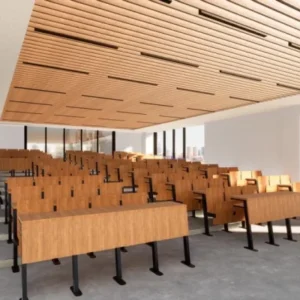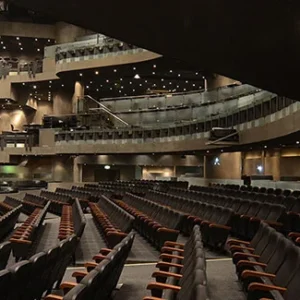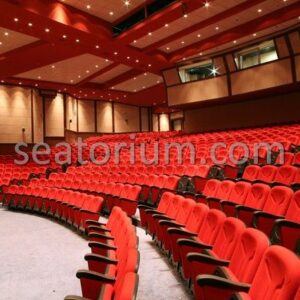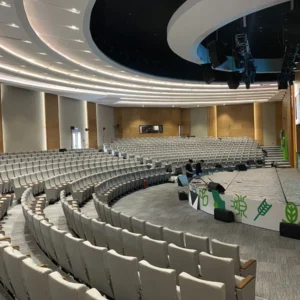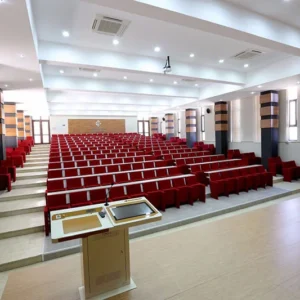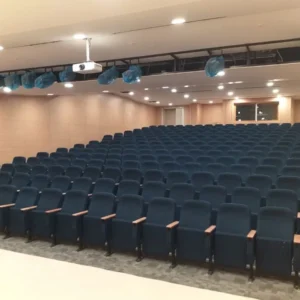In the world of large-scale venues, the question isn’t just “How many people can we fit?” — it’s “How can we do it better?” Whether you’re planning a renovation for an existing hall or designing a brand-new performance space, finding smart ways to increase auditorium seating capacity can unlock significant commercial value. But as anyone who’s managed venue planning knows, it’s never as simple as just adding more chairs. It’s about precision, creativity, and a deep understanding of spatial strategy.
If you’re overseeing a cultural center, a university amphitheater, or a multi-functional event venue, this article will offer practical, actionable insights. Let’s dig into the design logic and planning methods that have been helping venue professionals make every square meter count.
Table of Contents
Increase Auditorium Seating Capacity Without Compromising Experience
One of the biggest misconceptions in venue planning is thinking that more seats mean less comfort or diminished visibility. But it doesn’t have to be that way. Thanks to innovations in auditorium seating solutions, it’s entirely possible to add capacity while maintaining—sometimes even improving—the audience experience.
So, how exactly can seating capacity be increased efficiently?
- Seat footprint minimization: Manufacturers now offer modular auditorium chairs with slimmer profiles, allowing for tighter row spacing without sacrificing seat integrity or accessibility.
- Aisle reconfiguration: By slightly reducing aisle widths (within local safety codes), you can often recover dozens of additional seats in mid-sized venues.
- Balcony and gallery utilization: Vertical expansion, if structural conditions allow it, can introduce new tiers without altering the main floor layout.
Boosting capacity doesn’t mean sacrificing safety or sightlines—it just requires a smarter approach to layout and seating models.
Expand Auditorium Seating by Reimagining Underused Space
You might be surprised by how much potential lies in spaces that are currently underutilized. Dead zones around corners, unused technical spaces at the rear, or shallow backstage areas can often be transformed.
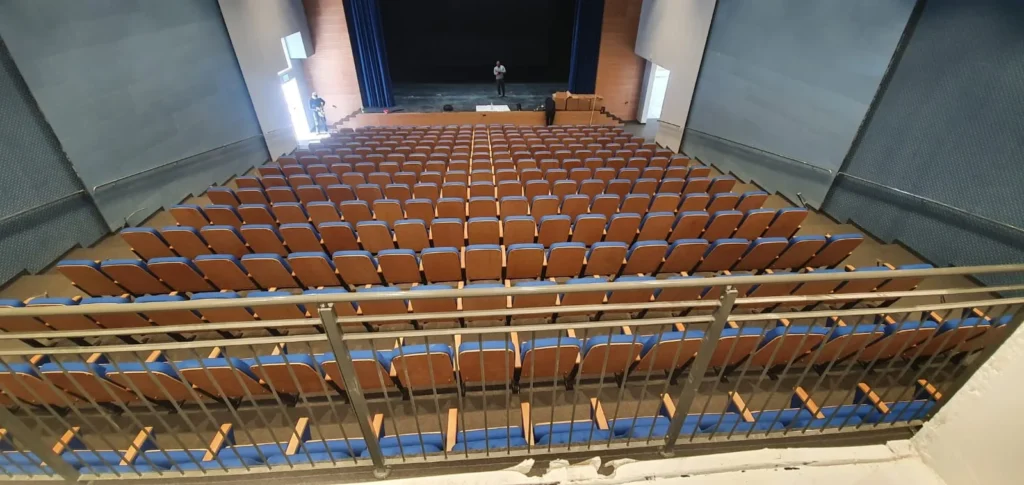
Hidden Opportunities in Layout
Have you ever reviewed your auditorium seating layout with a fresh set of eyes? Using professional space audit tools and virtual modeling, many venues discover that 5–10% of their footprint is unused or poorly optimized.
- Retractable auditorium seating can free up space for standing-room or temporary installations.
- Storage alcoves and side wings can be opened to expand seating wings.
- Even lobby areas in some auditoriums have been transformed into viewing areas using tiered, mobile seating.
Maximize Auditorium Seats Through Smart Design Decisions
Professional venue planners know: design is where capacity battles are won or lost.
From the very beginning of a new build or during major auditorium renovation ideas, planning teams should prioritize capacity-conscious design. It’s not just about where the seats go — it’s how people flow, where lines of sight land, and how access and egress function in a live event context.
Key Design Approaches
- Use venue capacity optimization software to simulate layouts and audience movement patterns.
- Apply staggered seating layouts to reduce wasted space and improve sightlines.
- Incorporate flexible auditorium seating options that can be rearranged based on the event type (lecture, performance, conference).
🔍 Wondering if changing seat orientation can increase capacity by 10% or more? In many cases, simply rotating seating angles by 3–5 degrees and adjusting row offsets has delivered exactly that.
Enhance Venue Seating Capacity with Modular Solutions
When your venue needs to do more with less, modular auditorium chairs can be a game-changer. Especially in multi-purpose venues, where seating must support everything from keynote speeches to orchestra performances, flexibility is more than a nice-to-have — it’s a necessity.
The Power of Modular Seating Systems
- Quickly reconfigure layouts for different audience sizes.
- Stackable or foldable options reduce downtime between events.
- Mechanical or automated systems can switch between flat-floor and tiered layouts within minutes.
For venues juggling high-frequency events or constantly shifting event types, modularity isn’t just about capacity — it’s about revenue. Every seat added means more tickets sold, more reach, and more flexibility for clients.
Optimize Auditorium Seating with Data-Driven Planning
Planning by intuition alone doesn’t cut it anymore. With advanced auditorium space management tools and 3D planning software, teams can simulate various seating arrangements and test their effectiveness before making costly changes.
Use Data to Guide Design
- Heat maps of foot traffic can identify congestion and help reallocate aisles or exits.
- CAD integrations allow seamless adjustments to auditorium design tips and layouts.
- Real-time simulations help test acoustic performance along with seating expansion.
📊 Is there a way to increase capacity while improving acoustic quality? With proper spatial modeling, yes — especially by integrating acoustic panels into ceiling and wall designs, freeing up floor space for seating instead of bulky diffusers.
What Should You Really Prioritize When Expanding Seating?
Here’s where experience comes into play. Professionals in this sector know that capacity gains aren’t just about numbers. It’s about delivering value across four fronts: audience comfort, visual engagement, safety compliance, and operational flexibility.

And let’s be honest — without a sharp eye for detail, even the best expansion plan can lead to compromised audience experience. When seeking to boost auditorium capacity, the goal is always strategic and sustainable growth, not short-term seat gains.
What’s Next for Smart Auditorium Capacity Planning?
Looking ahead, we’re seeing increasing interest in adaptable, tech-driven layouts. Automated retractable auditorium seating, mobile platforms, and sensor-driven occupancy tools are becoming the norm, not the exception.
Venues that invested in flexible systems during renovations are now seeing faster ROI, especially as hybrid events and dynamically sized audiences become more common.
🎯 Still wondering if now is the right time to rethink your seating strategy? If your venue is booked frequently, or you’re missing out on larger event opportunities due to size limits, then yes — the time is now.
Final Thoughts on How to Increase Auditorium Seating Capacity
Finding ways to increase auditorium seating capacity isn’t a one-size-fits-all task. It’s about precision planning, creative use of space, and adopting seating systems that work with your venue — not against it.
Whether through auditorium seating solutions, flexible seating layouts, or smart use of modular seating, the strategies are there. What matters is aligning them with your venue’s goals and long-term vision.
Don’t just aim for more seats. Aim for better ones. And more of them.

